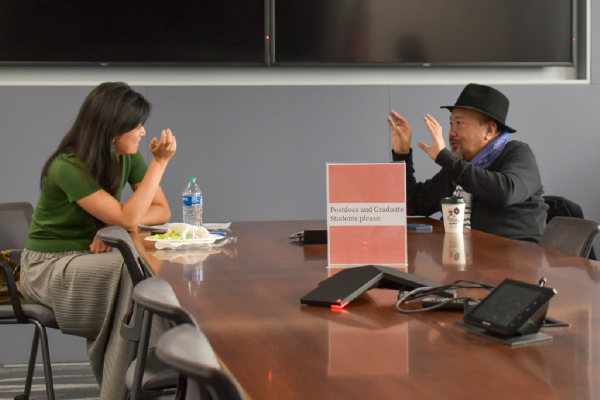Cambodian filmmaker Rithy Panh discusses difficult storytelling with Erin Lin

"You have to go and run to the image; the image will not run to you," Panh said, speaking about how he tells the story in his films.
Internationally acclaimed Cambodian filmmaker Rithy Panh had a conversation with Erin Lin, Assistant Professor of Political Science, and answered questions from the Mershon Monday audience this past week. Panh, who left for Paris as a teenager after the fall of the Khmer Rouge in 1979, has dedicated much of his career to investigating the campaign of genocide and memorializing its victims. Two of his films, The Missing Picture (2013) and Irradiated (2020) were shown last week at the Wexner Center for the Arts. Having “long pursued new ways of seeing modern history’s most resonant nightmares,” according to IndieWire, Panh has “always been desperate to reconcile the unimaginable with its absent sense of reality, and weaponize past trauma into a deterrent against the devastation to come.”
Erin Lin has long been an admirer of Panh's films and described the chance to interview the filmmaker as a "dream come true." Lin was on a Fulbright Scholarship in Cambodia in 2007-08 when she discovered his S21: The Khmer Rouge Killing Machine at a street market; The Missing Picture achieved international critical acclaim while she was in graduate school. Lin, whose research also addresses the sedimentation of war in Cambodian everyday life, describes Panh's work as helping her shape her identity as a scholar. But like his projects, her own quest "to speak with the dead" has taken its time. "I feel so lucky that this happened when it did. 4 or 5 years ago, I wouldn't have been at a point in my career where I would be ready to have that conversation."
Questions from Lin and the audience addressed the practical and ethical challenges of narrating collective trauma, especially when the witnesses are mostly dead and documentation is scarce or nonexistent. Lin suggested that Panh's filmic techniques-- reconstructing a family's path to the killing fields with clay figurines, composing a running "triptych" of archival footage from different 20th century humanitarian atrocities--should be thought of as experiments in representation. Panh added, "Freedom has a cost!": his aesthetic inventions result in part from the budgetary constraints of choosing to work outside the Western film industry. This independence, he went on, allows him to construct his films at a reflective, intentional pace--including periodic retreats to the Cambodian forest, away from social media. The forest, he reminded us, is the space of indigenous agriculture and its attendant rituals, now disappearing as mountain populations are incorporated into the national economy of rubber plantations and GM-modified food crops.
Nonetheless, Panh went on, he has recently agreed to work with Angelina Jolie as producer for a commercial film on the killing fields. In his view, such Western projects, though they tend to reduce local lives to the traumatic episode, are useful in calling international attention to otherwise forgotten relationships and responsibilities. As with his own films, he says, their most important value is local: to provoke conversations and to help young Cambodians discover what their parents do not want to talk about. Eventually, Panh said, forgetting could be good. "But without a film first, how can I forget?"
